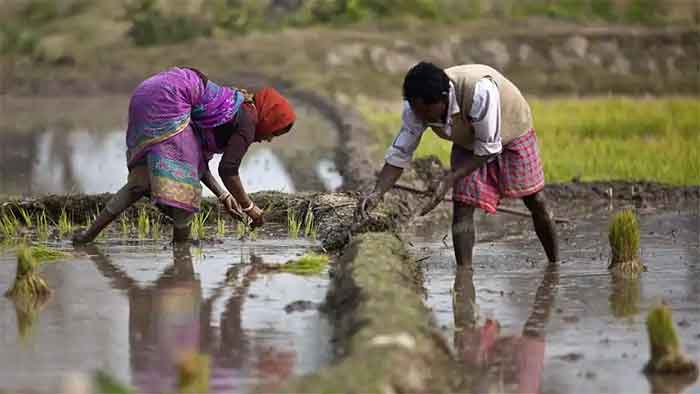
The category of ‘farmers’ is a hasty one, an entity perceived as homogenous by consumers in urban settings. This erases class, caste, gender and geopolitical differences which exist within the category of ‘farmer’, varying from large scale landholders, moneylenders and middlemen, to small or landless farmers and farm labourers. This is discounting agrarian producers not themselves involved in farming, but directly depend on for raw materials.
Punjab has the highest concentration of Dalits in the country (31.9 percent). However, only 5.7 percent own land. The reasons behind this, apart from the denial of land to lower castes, untouchability and other forms of economic and social deprivations, are also the vagaries of social formations. Social ties are key to decoding the politics of the land, so socially disadvantaged groups are more likely to be economically disadvantaged as well. Dalits form the main labourforce in the agricultural state. Yet, their position in Punjab, as elsewhere, is fragile. Gastronomic deprivations are not uncommon wherein a Dalit household is not able to procure household supplies. They are also barred from using the common lands, the shamlat, for grazing cattle, even though one third of it is reserved for them by law. [1]
The introduction of legislations such as the Land Alienation Act of 1900 made to protect the customary agricultural community, the Jats (which included Hindus, Muslims and Sikhs) from moneylenders, prevented the buying and selling of land by them to any other community, including landless Dalits. This was key in determining the nature of rural land ownership in Punjab, dominated by Jats.
In 1961, the state passed the Punjab Village Common Lands (Regulation) Act to reserve 33% of common land in villages for Dalits. This was unrealizable in a place where the trope of the ‘Dalit who cannot till’ is enduring. Dalits are used as a proxy for these lands by bigger players. Landless Dalit farmers, debarred from the ownership of large lands, have always put the request for land redistribution and land ceilings above the rest. Village collectives such as the Zameen Prapti Sangharsh Committee (ZPSC) have fought to claim land and emphasised its role in building dignity. [2]
However, the major demands of the protestors marching to Delhi against the anti-farmer bills are, the continuation and increase of MSPs (Minimum Support Price), and the retention of the customary middleman or arhtiya, who provides them with informal credit. Generally a member of the dominant Mahajan caste (business caste, belonging to the Bania or Brahmin communities), the arhatiya acts as a commission agent who connects the farmer to producers and government agencies. He arranges for the transport, packing and storage of the food grains, but is most sought out for his willingness to loan money to the farmer when the produce is less, or for marriages, foreign education, or hospitalisation.
When it comes to agriculture, size matters. Small and landless farmers were not able to be a part of the interlinked transactions provided by the arhtiya, who favoured Jat farmers.[3] Large landholding Jats occupy strong positions in the trade unions, bureaucracy and politics of Punjab, and share important ties with the arhtiyas on whom they are socially and economically dependent. As Jats themselves started becoming arhtiyas, they would keep the credit flowing in their own community. Eighty six per cent of all land holdings in India are small and marginal (less than 2 hectares).[4] The Shanta Kumar Committee Report of 2015 has iterated how the APMC mandis support large farmers much more than smaller ones. However, the MSP provides a useful shield for even small farmers against exploitation, also acting as a measure through which they could regulate their expenses.
So, while the protests against the anti-farmer laws have seen voices across classes and castes unite against the corporatization of agricultural markets, and the need to support the farmers through useful legislations such as the APMC Act [5], the long standing demand for land reforms, use of common lands by Dalit farmers, the need to empower them using collective and cooperative farming, have not been addressed or even raised by the ongoing debates. The size and productivity of the land will continue to matter even after land reforms. And yet, the demand of Dalit farmers such as those of women farmers in Sangrur, Punjab, for the right to a dignified life through the ownership of land, is every bit as sound as the demands of the farmers protesting at the Singhu border and elsewhere for the continuation of mandis.
Ambuja Raj is an M.Phil research scholar from the Centre for Studies in Social Sciences, Calcutta
[1] https://thewire.in/agriculture/farmers-protest-caste-rural-punjab-landowners-labourers
[2] https://countercurrents.org/2020/09/zameen-prapti-sangharsh-commitee-led-movement-in-punjab-a-turning-point-in-revolutionary-history-of-punjab-and-india/
[3] Sinha, Shreya Politics of the Market – Farmer trader relations under neoliberalism in Punjab Journal of Agrarian Change 2019 pp. 1-15
[4] https://www.thehindu.com/sci-tech/agriculture/indian-farms-getting-smaller/article25113177.ece
[5] https://timesofindia.indiatimes.com/india/bihar-junked-apmc-act-in-06-but-it-hasnt-benefited-farmers/articleshow/80078630.cms
IF YOU LIKED THE ARTICLE SUPPORT PEOPLE’S JOURNALISM
 RSS Feed
RSS Feed















 January 5th, 2021
January 5th, 2021  Awake Goy
Awake Goy  Posted in
Posted in  Tags:
Tags: 













